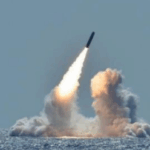
Flight tests for the Ground Based Strategic Deterrent missile, the planned successor to the nuclear-tipped Minuteman III, are scheduled to start in fiscal year 2024, according to a Pentagon environmental review of the new weapons. The service proposes four Ground Based Strategic Deterrent (GBSD) flight tests from Vandenberg Air Force Base in California in fiscal ‘24, according to the Air Force’s draft environmental assessment for the program, posted online and dated February 2021. That lines up with a notional schedule,…

 By
By 











